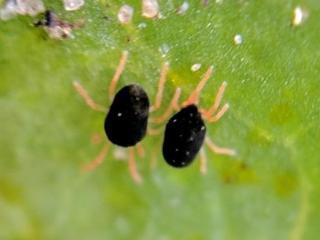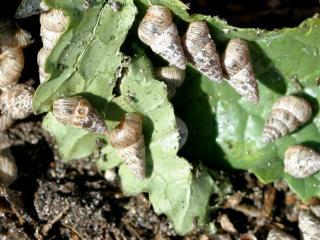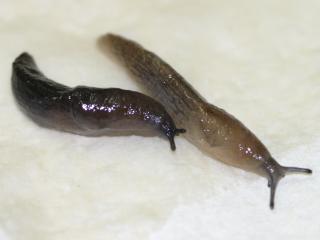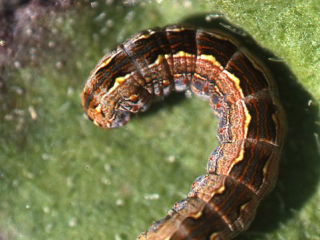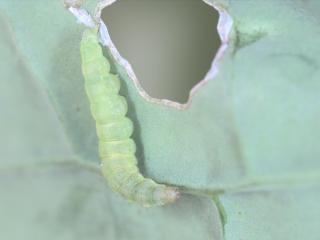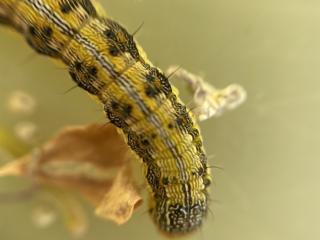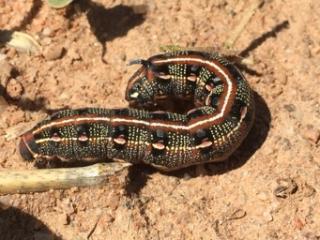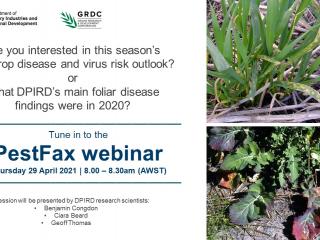Bryobia mites are active. Can you identify the different mite species?
- Aldersyde
- Kulin
- Wickepin
Technical officer Amber Balfour-Cunningham (DPIRD) has reported finding bryobia mites on roadside volunteer canola, wild radish and wild turnip near Aldersyde and Wickepin when conducting surveillance.
Justine Tyson (ConsultAg) reports finding bryobia mites on cotyledon Bonita canola near Kulin. There was no visible damage.
There are two species of bryobine mites that cause damage to WA broad acre crops; Brown wheat mite and bryobia mite (also known as clover mite).
Brown wheat mite is found in cereals only whilst Bryobia mite is found causing damage to canola and lupins. For more information refer to DPIRD’s Diagnosing brown wheat mite page.
These mites are most damaging to germinating crops when they transfer from dying weeds, due to a knock-down spray, onto germinating crops.
These mites are most damaging when crops are moisture stressed and temperatures are above 20oC. Growers are recommended to consider control only if crops are unable to out-grow feeding damage.
Correct identification of mites is critical for effective control, as different species can vary in their susceptibility to certain insecticide groups, either naturally or through insecticide resistance. Chemicals applied for control of the wrong pest may result in expensive loss of plant seedling density or having to re-sow some paddocks.
As weather conditions continue, it is expected that Balaustium mite will be also present in paddocks and cooler weather will lead to hatchings of earth mites (blue oat mite and redlegged earth mite).
Identifying different mites in crops
Adult bryobia mites are reddish-grey with a pie-shaped body, red legs and two long forelegs. For more information refer to DPIRD’s Diagnosing bryobia mite page.
The adult balaustium mite has a brownish / red body and red legs. If viewed under a magnifying glass or microscope it has short, stout, velvety hairs can be seen covering the body. The adult balaustium mite grows to almost twice the size of redlegged earth mites. Several generations can occur each year. For more information refer to the DPIRD Diagnosing balaustium mite page.
Redlegged earth mite (RLEM) adults are 1mm long with a black body and eight red-orange legs. RLEM have a cold temperature requirement (generally seven days below 20°C average daytime temperatures) before the eggs are triggered to hatch. Immature nymphal RLEM are often a more reddish colour than when they are mature. RLEMs do co-exist with blue oat mites so be careful not to incorrectly diagnose the two mites. For more information refer to the DPIRD Diagnosing redlegged earth mite page.
Blue oat mites look similar to RLEM (i.e. adults are 1mm long with eight red-orange legs and have a dark purplish-blue body) but they have a pale to red dot on their back. For more information refer to DPIRD’s Diagnosing blue oat mites page.
Bryobia mites and balaustium mites are more likely to be seen feeding on plants during warm and sunny parts of the day whilst RLEM and blue oat mites will be more noticeable feeding on leaves on overcast cool days or early morning / late afternoon.
You can confirm the identity of mites by using the DPIRD MyPestGuide Crops app which includes images and information of mite pests. Alternatively, you can send images for confirmation through the PestFax Reporter app.
Managing mites
Before spraying mites it is important to know that economic damage generally only occurs if mites are present in very high numbers or if the crop is moisture stressed. In many years, and under good growing conditions, mites emerge from eggs during or after crop germination and the plants outgrow mite feeding damage. For more information refer to DPIRD’s Earth mites - economic considerations for management page.
For registered insecticide recommendations for mites refer to DPIRD’s 2021 Autumn/Winter Insecticide Guide.
Growers and consultants are urged to apply integrated pest management (IPM) strategies when managing RLEM due to cases of insecticide resistance in WA. These strategies include; identifying mites, rotating different chemical groups and reserving co-formulations or chemical mixtures only for situations where damaging levels of RLEM and other insect pests are present.
For more IPM information see DPIRD’s Prevent redlegged earth mite resistance page and GRDC’s Resistance management strategy for the redlegged earth mite in Australian grains and pastures fact sheet.
For more information on mites contact research scientist Svetlana Micic, Albany on +61 (0)8 9892 8591.
Article author(s): Cindy Webster (DPIRD Narrogin) and Svetlana Micic (DPIRD Albany).
Locusts can damage emerging crops
- Beacon
- Wialki
- Bonnie Rock
- Cadoux
- Koorda
- Yerecoin
- Mukinbudin
- Southern Cross
- Merredin
- Beverley
- Grass Patch
- Scaddan
- Jerramungup
There have been reports of winged Australian plague locusts (APL) in many parts of the broad acre growing regions of WA. Higher densities are located in shires that have had rainfall events in December 2020 and January 2021. This rainfall has led to a green bridge which has provided a food source for APL.
A consultant has also reported suspected APL damaging 4-leaf canola near Koorda. Locusts were coming in to the paddock from nearby bush.
APL usually cause damage to crops that are in close proximity to green pastures, roadside weeds. APL have a preference for grasses but can cause damage to crops.
How to identify Australian plague locusts and grasshoppers
APL are sometimes found with a range of other, similar looking species of non-winged grasshoppers.
The Australian wingless grasshopper (Phaulacridium vittatum) can be confused with the Australian plague locust, especially at the immature stage.
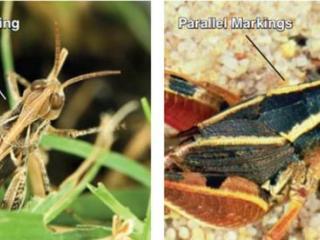
The Australian plague locust hopper (left) has a white X-shaped marking on the back of its thorax as its main identifier, while marking is more parallel in the Australian wingless grasshopper (right). Photos courtesy of: DPIRD.
APL always have an x-shaped marking behind the head. In nymphs this can be faded and becomes more visible with maturity, but it is always present.
Adult APL have a dark spot on the otherwise clear hind wing. The dark spot looks like an elongated smudge. They also have red tibia. This distinguishes them from all other species.
For more tips on identifying APL refer to DPIRD’s Australian plague locust: identification field guide page.
APL activity will diminish with the start of wet and cooler weather conditions. For APL to be mobile, they need warm days to move across the landscape.
You can also use the PestFax Reporter app to request a diagnosis or report this activity so the PestFax team can display it on the PestFax map and alert other WA growers.
Managing Australian plague locusts
When there are higher numbers of APL (more than 10 per square metre) in pastures adjacent to paddocks that have emerging crops, those crops may be at risk from APL damage, especially as there has been warm weather experienced during the start of this growing season.
The best strategy is to monitor seeded paddocks for locust numbers and apply a direct application of insecticide if they are damaging emerging crops.
There are a number of chemicals registered for locust control including many that are used in canola paddocks for other pests. While synthetic pyrethroids may have been used in a knockdown mix these sprays are not going to have much residual value to protect crops now.
Sprays have better efficacy if applied early in the morning of a day that will be warm. APL adults are more likely to come into direct contact with the spray as they do not move quickly when it is cool. As the day warms up, adults will move onto sprayed vegetation and are more likely to ingest sprayed vegetation. Continue to monitor paddocks as locusts may reinfest a treated area.
For insecticide information visit DPIRD’s Australian plague locust control: registered insecticides page.
Growers that are finding APL now, and later in May, will need to monitor paddocks that had APL activity for egg hatchings from mid-September. Egg beds are usually laid in bare ground.
Further APL information can be found at DPIRD’s Australian plague locust overview page.
For more information contact Research scientist Svetlana Micic, Albany on +61 (0)8 9892 8591.
Article authors: Cindy Webster (DPIRD Narrogin) and Svetlana Micic (DPIRD Albany).
Slugs and snails are damaging canola
- Moolanup (Munglinup)
- South Stirlings
- Woogenellup
Quenten Knight (Agronomy Focus) has reported that slugs and small pointed snails are causing damage to canola at the cotyledon stage near Munglinup. Slugs were predominantly causing damage to canola in areas of the paddock with heavy loamy clay soils. Snails were wide spread. The paddock was going to be baited.
At South Stirlings and Woogenellup growers have reported that snails are active, and infested crops have been baited post seeding and are being monitored.
Baits will compete with the germinated crop to be attractive to slugs and snails.
A single well timed bait can control slugs, however small pointed snails will only feed on baits if they encounter them.
If the crop has emerged, baiting at the highest registered rate and ensuring even bait coverage will lead to a better chance of snails and slugs encountering the baits and feeding on them. However, a follow-up bait may still be required especially if there is a future rain event of 10mm of more.
How to check crops and manage slugs and snails
Irregular pieces chewed from leaves and shredded leaf edges are typical of snail and slug presence in crops. Damage to canola and legume crops can be difficult to detect if seedlings are chewed down to the ground during emergence. Emerging canola is especially susceptible to damage.
Monitor crops for damage. Slug numbers as low as 1 per square metre can be damaging to a germinating canola crop. Refer to DPIRD’s suggested snail and slug threshold numbers in broadacre crops.
DPIRD research has shown slugs and snails are active at night; and if humidity is above 70% consider looking for slugs and snails after dark.
Slug identification- burning may not have controlled them
There are two slug species that are pests of broadacre crops the black keeled slug and the reticulated slug. Other slug species can be present in the paddock but they are not crop pests. The black keeled slug is usually black with a prominent ridge down the back, whereas the reticulated slug is often light grey-fawn with mottled markings. Black keeled slugs can burrow 20cm or more below the surface and are readily able to survive paddocks which have been burnt. The reticulated slug does not borrow and is less likely to survive in paddocks that have been burnt. For more information refer to DPIRD’s Diagnosing slugs in crops page.
Snail identification

There are three snail species (small pointed or conical, vineyard and white Italian) snails that are pests of WA broadacre crops. The small pointed snail has a conical shell with brown bands of varying width. It is usually less than 10mm in length or diameter and occurs on all soil types in the high rainfall area. The white Italian snail is up to 30mm across, white with broken brown bands. The vineyard snail is up to 20mm across with almost continuous brown bands. The vineyard and the white Italian snail prefer alkaline sandy soils. For more information refer to DPIRD’s Diagnosing snails in crops pages.
Biology
Snails and slugs have similar biology. They are hermaphrodites which enable both members of a mating couple to lay eggs. Mating usually takes place from mid-autumn to mid-winter when favourable moist conditions prevail after their long summer aestivation. Two to four weeks after mating, spherical pearl-white eggs are laid into moist soil. Egg laying can continue from the break of the season to late winter. After laying, eggs hatch in 2-4 weeks, the young slugs and snails usually become sexually mature after one year.
Eggs laid by snails this season contribute to snail numbers next year.
For more information on slug and snail control visit:
- DPIRD’s 2021 PestFax Pre-season Issue article Bait for snails before egg laying occurs
- DPIRD’s Identification and control of pest slugs and snails for broadacre crops in WA page
- GRDC’s Bash’Em Burn’Em Bait’Em: Integrated snail management in crops and pastures publication
- GRDC’s Snail baiting as part of an integrated pest management strategy video.
For more information contact Svetlana Micic, Research Officer, Albany on +61 (0)8 9892 8591.
Article authors: Cindy Webster (DPIRD Narrogin) and Svetlana Micic (DPIRD Albany).
Tips for identifying caterpillars and remember beneficials when spraying
The PestFax team have been receiving reports of a variety of caterpillar species activity in volunteer canola re-growth, wild radish and wild turnip volunteers on roadsides across the grainbelt from as north as Mullewa to as south as Coomalbidgup.
As early sown crops start to emerge a few caterpillars are being found in crops also.
Visit the DPIRD PestFax map to see specific caterpillar reports and their locations.
Similar to last year, considerable summer rainfall from cyclonic activity has resulted in unusual moth flights from the north eastern pastoral areas to the northern and central agricultural regions. Caterpillars that have hatched have had green volunteer plant material (green bridge) to feed on where regrowth has not been sprayed yet.
The following caterpillar species are currently being found and reported.
Brown pasture looper
- Mukinbudin
- Cunderdin
- Muresk
- York
Brown pasture looper (BPL) caterpillars have been found in flowering road side wild radish (along with cabbage centre grubs) near Mukinbudin, Cunderdin, Muresk and York.
BPL are slender caterpillars that are grey or brown in colour with black and cream stripes. Young caterpillars move with a characteristic looping motion. When the caterpillars reach full size at 30mm long, they cease to move this way.
Weed web moth and cabbage centre grubs
- Weed web moth - Bruce Rock & Northam
- Cabbage centre grubs - Most port zones
Weed web moth caterpillars have been found in wild radish near Bruce Rock.
A farmer near Northam reports finding weed web moth damaging his 4-6 leaf canola.
There have been lots of reports of cabbage centre grubs being found in wild radish and volunteer canola in most port zones by staff and grower groups who have been conducting green bridge surveillance. To view locations refer to the PestFax map.
Weed web moth and cabbage centre grubs are in the same family (Crambidae) and can look very similar, especially the brown banding down the body of caterpillars. The most distinguishing characteristic of weed web moth is the dark circles or spots along the body.
Both species produce webbing amongst the leaf tissue. This webbing produced by both pests can give them some protection from chemical sprays.
Both cabbage centre grub and weed web moth are minor early establishment pests that rarely reach high enough numbers to cause economic damage. However, weed web moth can be problematic in warmer than average years with early autumn rainfall.
Diamondback moth
- Geraldton port zone
- Kwinana East and Kwinana West port zone
- Albany port zone
David Stead (Anasazi Agronomy) has reported that diamondback moth (DBM) are present in tillage radish, sown for forage mix, at Cadoux and that there are large numbers of DBM in volunteer canola north of Calingiri.
DPIRD, in conjunction with local grower groups, have been conducting a DBM survey since March. Staff placed 290 traps on roadsides from Northampton to Esperance where brassicas (wild radish, wild turnip, volunteer canola) were found.
The map of the DBM survey (below) shows where we found a green bridge and if roadside brassicas were present. Traps were placed at brassica locations which will be collected this and next week to measure any DBM presence in the region. The map also shows the locations of DBM caterpillars found in March. This information may help us determine if a green bridge will influence DBM populations and where populations develop in the growing season.
DBM caterpillars are pale green, cigar-shaped and up to 12mm in length. They wriggle violently when disturbed and can drop down on a fine thread. For more DBM information refer to DPIRD’s Diagnosing diamondback moth page
Lesser and native budworm
- Lesser budworm - Mullewa
- Native budworm – Morawa, Northam, Cunderdin, Cranbrook and Coomalbidgup
Nick McKenna (Planfarm) has found what is suspected to be lesser budworm (Heliothis punctifera) on millet near Mullewa.
Native budworm caterpillars have been found on wild radish at Morawa, Northam, Cunderdin, and Cranbrook. They have also been found in a pasture near Coomalbidgup.

Native budworm and lesser budworm caterpillars are closely related and look very similar to each other. To distinguish between the two species lesser budworm larvae are usually dark in colour, while native budworm varies from black to green to light brown in colour. Both have a light coloured strip down each side of the body. For older larvae (>20mm in length), lesser budworm has white hairs on the collar (segment behind the head) and the body, while native budworm has black hairs on the collar and black to blackish-brown body hairs.
Hawk moth
- Merredin
Hawk moth caterpillars have been found on weeds near Merredin.
Young hawk moth caterpillars are green with a dark dorsal line ending in a stumpy black tail spike but final instar caterpillars may be green, brown, or black. The tail spike becomes strongly curved backwards. Their known hosts are lucerne and multiple weed species including hogweed, tar vine and pigweed.
How to identify caterpillars
Caterpillars can be tricky to correctly diagnose sometimes due to their similarities in appearance. Fortunately growers and consultants can use the free PestFax Reporter app to request a diagnosis. Users just need to take clear close up photos of the caterpillar and plant damage and attach with any other helpful background information when submitting a report.
It is important to be able to correctly identify and know which green bridge pests can pose a risk to emerging crops.
Hawk moth and cabbage centre grub caterpillars are very rarely seen damaging crops but brown pasture looper, cutworm, native budworm, webworm, DBM and pasture day moth caterpillars can cause feeding damage if present in sufficient numbers.
Growers need to be mindful that caterpillars and other pests such as aphids may transfer from roadside and paddock green bridge onto vulnerable emerging crops if the green bridge isn’t destroyed for at least two weeks before crop emergence. Caterpillars and aphids need a green host to feed on or they will starve and die. This includes eggs laid by moths which must hatch and do not go dormant on green or dead plant material in the lead up to crop germination.
Managing caterpillars and considering beneficials
If numbers warrant spraying then growers and consultants can refer to DPIRD’s 2021 Autumn Winter Spring Insecticide Guide.
Growers should consider insecticide options that are soft on predator insects if spraying. Research scientist Christiaan Valentine (DPIRD) recently found predatory spined shield bugs and native budworm caterpillars in wild radish near Northam. When he brought live samples back to the office he was able to capture on film the spined shield bug successfully consuming a small native budworm caterpillar. To watch the video on Twitter click here .
For more information on beneficials refer to DPIRD’s Know what beneficials look like in your crop page.
For more information contact Svetlana Micic, Research Officer, Albany on +61 (0)8 9892 8591.
Article authors: Cindy Webster (DPIRD Narrogin) and Christiaan Valentine (DPIRD Northam).
Article input: Dusty Severtson (DPIRD Northam) and Svetlana Micic (DPIRD Albany).
2021 autumn winter insecticide spray guide is now available
The 2021 autumn winter insecticide guide is now available and can be downloaded for free at the department’s Insecticide spray guides for crops in Western Australia page.
This spray guide lists the current registered chemicals and rates that can be applied to canola, cereal and lupin and other grain legume crops for controlling seedling insect pests. This includes foliar sprays and seed dressings.
The department updates its autumn/winter and winter/spring insecticide spray guides annually to help growers and consultants manage insect pests in crops and pasture.
The spray guides are only a guide and growers still need to read chemical labels before use.
Not all insecticide trade names may be listed so growers should also check with their retailers for any other registered insecticide options.
If beneficial invertebrates are present in the paddocks growers should consider insecticide options that are soft on predator insects if spraying. For more information on beneficials refer to DPIRD’s Know what beneficials look like in your crop page.
To download these spray guides and other useful insecticide information visit the department’s Insecticide spray guides for crops in Western Australia page.
For more insecticide information contact Amber Balfour-Cunningham, Technical officer, Northam on +61 (0)8 9690 2137 or Dustin Severtson, Research scientist, Northam on +61 (0)8 9690 2160.
Article authors: Cindy Webster (DPIRD Narrogin) and Dusty Severtson (DPIRD Northam).
PestFax foliar and virus disease findings and risk outlooks for WA crops webinar
You are invited to register and attend our upcoming PestFax webinar.
Date: Thursday 29 April 2021
Time: 8.00 – 8.30am (AWST)
DPIRD research scientists Ciara Beard, Benjamin Congdon and Geoff Thomas will be discussing the following topics in this webinar:
- Findings of foliar disease surveillance activities in broad acre crops in 2020.
- The green bridge and foliar disease risk outlook for WA broad acre crops this season.
- Aphid and virus green bridge findings and risk outlook for 2021.
There will be time for questions and discussion at the end of the webinar.
After registering you will receive a confirmation email containing information about joining the webinar.
For more information contact PestFax newsletter editor Cindy Webster, Narrogin on +61 (0)8 9881 0201.
Article author: Cindy Webster (DPIRD Narrogin)




